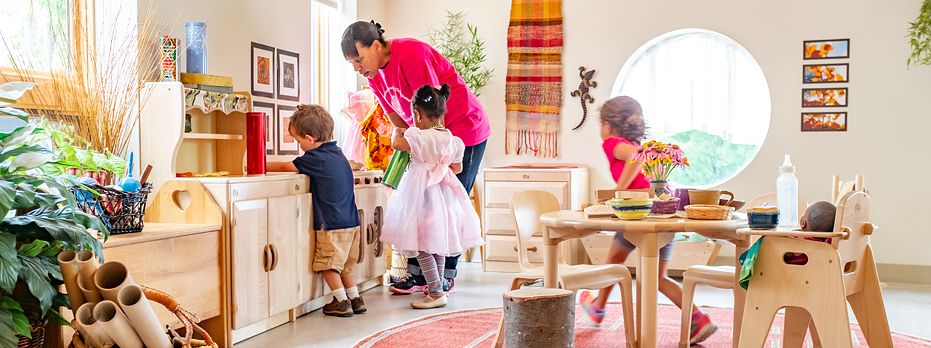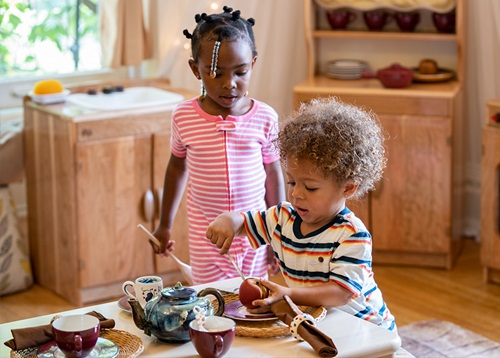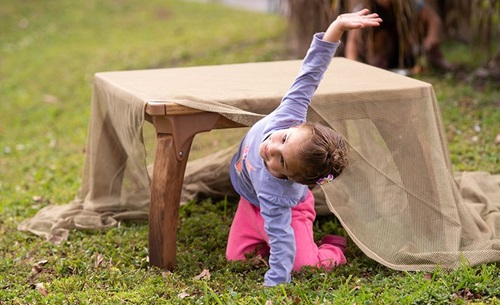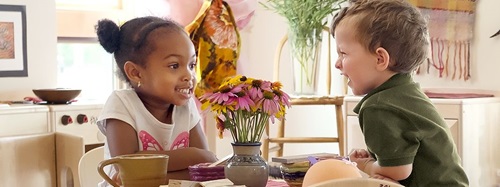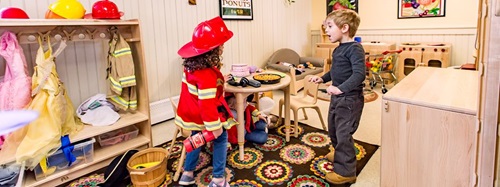The House Area
| February 2005The house area supports both individual and cooperative play. Many children spend considerable time in the house area—stirring, filling, emptying, pouring, shaking, mixing, rolling, folding, zipping, buttoning, snapping, brushing, trying things on and taking them off. They may imitate cooking sequences they have seen at home or pretend to feed a doll or stuffed animal.
Children involved in exploring, imitating, and pretending in the house area are often content to play by themselves or alongside others. Other children play there with friends, acting out familiar roles—moms, dads, stepparents, babies, brothers and sisters, aunts and uncles, grandparents, firefighters, store clerks, babysitters, pets.
Children also re-enact events they have experienced or heard about—visiting the dentist, going to the emergency room, moving, going shopping, talking on the phone, cleaning up after a flood, visiting daddy, having a birthday party, dressing up to “go out,” celebrating holidays, going to church, and attending weddings, funerals, picnics, and movies. By providing a setting for role play, the house area allows children to make sense of their immediate world. Children have numerous opportunities to work together, express their feelings, and use language to communicate roles and respond to one another’s needs and requests.
Location
Since house area play often extends into the block area, locating the house area next to, or across from, the block area, as noted earlier, allows this interaction to occur with a minimum of distraction to children working elsewhere. Providing space for more than one kind of role play is another important consideration in arranging the house area. Allocating enough space so one part of the house area can be defined as a kitchen, for example, while leaving another part open, allows children to set up a living room, bedroom, back yard, garage, workshop, doctor’s office, spaceship, store, fire station, stage, or whatever setting they need for the particular role play they have in mind. One early childhood team converted a small alcove into an additional role-play space by covering the alcove opening with a piece of plywood into which they cut a door and two windows.
Low storage shelves, child-sized appliances or sinks, a refrigerator, storage boxes, and a free-standing mirror or door can all serve as house area boundaries. In one house area, a puppet stage that often becomes a store counter helps to define the area. In another, a loft house facing into the center of the room provides a boundary as well as a versatile role-play space. Depending on the children’s play, the loft becomes a boat, a hideaway, a pet store, a castle, a spaceship, or a “gingerbread house.”
Materials
House area materials include cooking and eating equipment and all kinds of materials for dramatic play. The list of house area materials below includes many things adults can purchase at garage sales, flea markets, thrift shops, and discount stores. When they are aware of the need, some businesses will donate items they no longer use. For example, a hotel that is changing its locks may donate the old keys, and a fabric store may donate fabric remnants.
As you equip the house area, it is important to provide child-sized appliances and adult-sized utensils. A child-sized sink, stove, and refrigerator are built so young children can comfortably reach and use them. A child-sized sink, for example, could be a real sink built on a small scale or a wooden unit including a tub for water. We recommend adult-sized utensils and dishes because they are generally more durable than the toy utensils made for children; they allow for larger motions, and they hold more “food.” Children seem to prefer the “real thing,” probably because they see adults using spoons, mixing bowls, strainers, and so forth at home and the urge to imitate adult actions is powerful.
Props—collections of materials related to particular roles—are also important house area equipment. Some props come from field trips. A farmer, for example, might contribute an empty feed sack, a piece of rope, or a bale of straw. Special role-related articles of clothing are often stored in prop boxes—the hospital box contains a lab coat; the farmer box, a pair of overalls. Other “everyday” dress-up clothes (hats, dresses, pants, scarves) are always available.
A round preschool table with chairs in the house area accommodates real and pretend cooking, real and pretend family-style meals and snacks, and small-group projects.
Making the house area homelike
You can welcome children to the house area by making it as much like children’s real homes as possible. This may mean, in one center, having a brightly colored tablecloth and flowers on the table or, in another, earth-colored mats and candles. The house area might include futons, hammocks, woven mats, or quilts, depending on what children are familiar with. In some parts of the country you might see kindling, logs, and the outer casings of a wood-burning stove. Suitcases may figure prominently in the house area in a community where children move or travel a lot. Depending on the population, the empty food boxes may have original labels in Spanish, Japanese, Chinese, Thai, Korean, Arabic, or Croatian. Dress-up clothes may include saris, obis, multilayered skirts, or wide sashes.
Accessible storage
Many odd-shaped, one-of-a-kind materials in the house area present storage challenges. Her are some strategies that might help:
- Hang pots, pans, and utensils on pegboard or wall hooks, tracing their outlines as they hang, and fastening the labels behind the hanging objects.
- Use the space organizers people use in their homes—silverware trays, cup racks, spice racks, plate racks, and canisters. Canisters labeled with a picture or an object can be used to store loose items for cooking, such as stones, buttons, seeds, and beans
- Store clothing and accessories just as they are stored in people’s homes—on hooks (easier than hangers), in drawers, and in boxes (with labels). Sometimes the container itself serves as its own label—a hanging shoe holder for shoes, a jewelry box for jewelry, a towel rack for towels, a bed or chest for blankets.
- Position labels in the same way in which an item is stored. For example, trace the outline of a coffeepot and attach the tracing to the wall directly behind the spot on the shelf where the coffeepot is stored.
House Area Materials
Cooking and eating equipment
Child-sized sink, stove, refrigerator
Adult-sized forks, spoons, knives, chopsticks
Cooking containers: pots, pans, wok, rice cooker
Cooking tools—
- barbecue cooking utensils
- slotted spoons, spatulas, ladles
- eggbeater, whisk, food mill, mortar and pestle
- sand timer, bell timer
- teapot, coffeepot
- colander, sieves
- ice-cube trays
- cookie press and cutters
- hamburger press, tortilla press
- can opener
Baking equipment—
- cake pans, muffin pans, loaf pans
- mixing bowls and lids
- measuring cups and spoons
- rolling pins
- sifter
- canister set
- dishes—plates, bowls, cups, saucers
- sponges, dishcloths, towels, potholders
- tablecloths, placemats, napkins
Things to cook and serve—
- seeds, seed pods, beans, nuts, shells, stones, pine cones
- chestnuts, acorns, macaroni, noodles, buttons, bottle caps, poker chips,
- foam packing pieces, fabric squares for wrapping
Empty food containers—
- boxes, cans, cartons, jars, and bags, with original labels in English, Japanese, Arabic, Spanish, and so forth to reflect children’s home languages
Pretending and role-play materials
Dolls—
- female and male, commercial and homemade, to reflect the skin colors, hair styles, facial features, and special needs of children in the program
- Stuffed animals
- Doll beds, blankets, stroller, front/back pack
- Baby rattles, bibs, bottles, diapers, clothes (pants and dresses)
- Broom, dustpan
- Toaster (wooden or de-electrified), clocks (wind-up or de-electrified)
- Mirror
- Two telephones
- Small stepladder
Dress-up clothes and accessories—
- hats, shoes, purses, wallets, briefcases, scarves, head wraps, jewelry, masks, neckties, belts, suspenders
- Lunch boxes, picnic basket, laundry basket
- Toolbox and tools
- Envelopes, canceled stamps, seals, stickers, junk mail
- Typewriter, keyboard
- Sturdy cardboard boxes
- Low, movable partitions
Props—
- home-builders’ props: toolbox, tools, empty paint cans, brushes, pipe fittings
- doctor’ props: lab coats, Band-Aids, gauze, stethoscope, cloth bandages
- farm props: overalls, pail, straw, animal brush, empty feed bag
- gas-station props: empty oil can, hose, rags, empty paste-wax can, jack, lug wrench, steering wheel, hubcaps
- fire-station props: hats, raincoats, boots, hoses
- restaurant props: hats, aprons, cups, straws, napkins, menus, order pads and pencils
- fishing props: fishing poles, nets, heavy boots, sou’westers, buckets, oars, gas can, buoys
Homelike materials:
- Rocking chair or easy chair
- Blankets, sheets, quilts, pillows, beach towels, sleeping bags
- Photos of program’s children and their families
- Wall hangings reflecting local community
- Real plants, watering can
Real cooking equipment: (stored out of children’s reach and used only with an adult present)
- Hotplate, toaster oven
- Electric frying pan
- Popcorn popper with clear lid
Reference photos and recipes:
- Cookbooks, picture recipes
- Field-trip photos (for role-play ideas)

